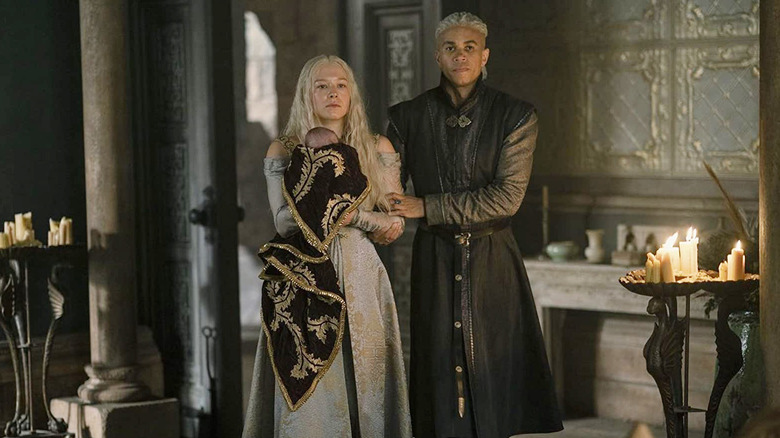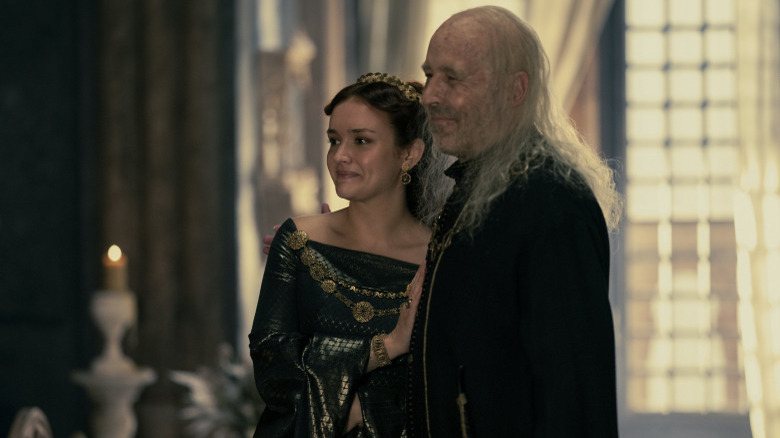House Of The Dragon Can Do One Filming Technique Game Of Thrones Never Could
This post contains spoilers for "House of the Dragon" episode six.
Revisiting the early seasons of "Game of Thrones," it's hard not to notice how much HBO's fantasy behemoth started out looking like, well, a TV show. By the end of its run, of course, the series had production values and a budget to rival that of any tentpole film. But more than that, it was the panoramic visuals and refined filming techniques that really made those later seasons feel cinematic (their flawed writing aside).
The show's prequel/spin-off series "House of the Dragon" has the advantage of a huge budget right off the bat. In spite of the show's deliberately murky lighting and unflattering color grading, there's no doubt HBO spared no expense in bringing Westeros back to the small screen. For as much as the series centers on small groups of people plotting and politicking behind closed doors, its luxuriant sets and costumes belie the intimate scope of its personal drama.
"House of the Dragon" episode six, "The Princess and the Queen," highlights another benefit that comes with having vast, connected interior sets. In its opening, a now-adult Princess Rhaenyra Targaryen (Emma D'Arcy) is shown giving birth in a scene that's all the more painful for what we hear, not what we see. Poor Rhaenyra barely has time to put her dress back on before Queen Alicent Hightower (Olivia Cooke) demands to see her newborn child. What follows is a tracking shot that would have been impossible to do on "Game of Thrones" yet serves a key storytelling purpose here.
The longest stair climb in the history of stair climbs
Whenever one chooses to shoot a scene in a single take, there should always be a reason for it other than, "Hey, this looks cool!" Take films like "Birdman" and "1917," which are famously designed to look like they were shot without any cuts (or, in the latter case, like's it done in two single takes). Both movies are about characters who are racing against the clock to complete a task. By never cutting, they keep us as viewers locked in the same state of anxiety as their leads.
The tracking shot in "House of the Dragon" episode six has a similar effect. As we follow Rhaenyra and her caring but clueless husband Ser Laenor Velaryon (John Macmillan) up the mammoth stairs at the center of the Red Keep, you can't help but feel the excruciating agony Rhaenyra suffers with every single step she takes. It only makes Laenor's misguided attempts to comfort her along the way all the more worthy of an eye-roll. Her calm reply ("My deepest sympathies") cuts deeper than any blend of curse words and insults she could conjure up.
There's another perk that comes with shooting the scene this way and it's the glimpses we get of people gawking at Rhaenyra as she walks by. Had her climb been filmed in the shot/reverse shot style typical of TV, it would have been harder for the show to get across just how intrusive and suffocating these on-lookers' presence is for our resilient princess. Instead, we see there really is no escape for her. If she falls down or falters for even a moment, basically the entire castle will know about it right away.
Why immersive sets matter
Due to its early budget limits, the sets for the Red Keep in "Game of Thrones" weren't built to accommodate this type of filmmaking. As such, interior scenes had to be assembled in a far more piecemeal fashion, with characters shown talking in one area of the castle before the scene cuts to them continuing their discussion or talking to other people elsewhere. It was the writing and acting that really made these exchanges come to life, less so the camera work.
With "House of the Dragon," on the other hand, the sets could be constructed to allow for this type of immersive filming technique. This was no accident, either. In behind-the-scenes footage from the show, director and executive producer Miguel Sapochnik explained that the Red Keep was designed so he would be able to "shoot in every direction without it becoming a visual effect." Production designer Jim Clay similarly referred to this location as "the jewel of the whole piece," with the castle's central staircase acting as a symbol of power for those who rule King's Landing.
Both of these ideas are at play in the tracking shot from episode six. It's a great way of showing how the power dynamic has shifted between Rhaenyra and Alicent in the 10 years since episode five took place without spelling it out through dialogue, even before Alicent appears on-screen. Having more resources doesn't always make for better storytelling in TV and film (quite the opposite, more often than not). But by using them with purpose the way this scene does, it proves "House of the Dragon" can actually improve on the thing "Game of Thrones" did best: people walking and talking in castles.
"House of the Dragon" premieres new episodes Sunday evenings on HBO and HBO Max.

